HinduOfUniverse
Indian Gurus
Anyone interested in the spirituality and mediation looks for a Guru or a
teacher who can guide him in the right direction. The land of India is full of
Gurus, spiritual as well as religious. These are the people who have promoted
spirituality, meditation, love, peace, brotherhood, serving others and other
such humanitarian values to people in India and the rest of the world.
In this section on Indian Gurus, we have provided a brief biography of the
following spiritual and religious leaders in India…
Shirdi Sai
Baba
About Sai Baba
Sri Shirdi Sai Baba is considered to be the epitome of spiritual enlightenment
and religious harmony. One of the greatest saints ever born in India, He is
believed to be a manifestation of God. His main aim in life was to make people
realize the eternal truth "Sabka Malik Ek" (One God governs all). He always
preached people to follow the path of Shraddha (devotion) and Saburi
(patience). Read this biography further to know about the life history of Shri
Shirdi Sai Baba.
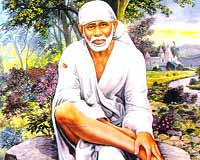 His Life
His Life
No authentic information is available about the birth and the early life of
Sri Sai Baba. It is believed that He was born to Hindu parents, but raised by
a Muslim couple. The only records that are available are from the time He made
His appearance in Shirdi, a small town near Nashik city of Maharashtra. It is
said that He was first seen in Shirdi, sitting in a meditative posture under a
Neem tree. The radiance on the face of the young boy, along with the intense
meditation He was undergoing, attracted the villagers towards him.
It is said that Sri Sai Baba left Shirdi after a period of three years and
came back when He was twenty years old, accompanying a marriage party. In
Shirdi, He mostly stayed in an abandoned mosque, situated in the outskirts of
the village. Later, the mosque came to be known as 'Dwarikamai'. With time,
Sai Baba came to be known in places far away from Shirdi. This time, Baba
remained in Shirdi for a period of sixty years. It was in Shirdi only that He
attained Maha Samadhi (salvation) in 1918.
Mission of Shri Sai Baba
The main aim of Sri Shirdi Sai Baba was to spread the feeling of unity and
brotherhood throughout the world. He preached that there is only one God, who
is the master of all the human beings. God loves each and every person,
irrespective of his/her vices or virtues. Similarly, we should also love each
other, irrespective of the religion, caste, creed, etc.
Sai Baba Incarnations
Sri Sathya Sai Baba of Puttaparthi is considered to be an incarnation of
Shirdi Sai Baba. It is belived that Sai Baba will reincarnate himself again in
the world for the third and final time, in the form of Prema Sai Baba.
Valmiki
About Valmiki
Maharishi (the great sage) claims the distinction of being the author of the
holy epic 'Ramayana', consisting of 24,000 verses. He is also believed to be
the author of Yoga Vasistha, a text that elaborates on a range of
philosophical issues. Written approximately 500 years ago, it was taught to
Lord Rama when He lost all the hopes in life. Read on this biography to know
more about Maharishi Valmiki and his life history.
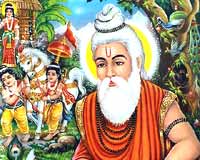 Early Life
Early Life
Maharishi Valmiki was born as Ratnakara to sage Prachetasa. At a very young
age, Ratnakara went into the forest and got lost. A hunter, who was passing
by, saw Ratnakara and took him under his own care. Under the love and care of
his foster parents, Ratnakara forgot his original parents. Under his father's
guidance, Ratnakara turned out to be an excellent hunter. As he approached
marriageable age, Ratnakara was married to a beautiful girl from hunter's
family.
Turning into a Robber
As his family grew larger, Ratnakara found it next to impossible to feed them.
As a result, he took to robbery and began looting people passing from one
village to another.
Meeting with Narada and Transformation
One day, the great sage Narada, while passing through the jungle, was attacked
by Ratnakara. As Narada played his Veena and sang praises of the Lord, he saw
a transformation coming over Ratnakara. Then, he asked Ratnakara whether the
family, for whom he was robbing others, will partake in his sins also.
Ratnakara went to ask the same question to his family and on being refused by
all his family members, he went back to sage Narada. Narada taught him the
sacred name of 'Rama' and asked him to sit in meditation, chanting the name of
Rama, till the time Narada came back.
Ratnakara followed the instructions and kept sitting in a meditative posture
for years, during which his body got completely covered by an anthill. At
last, Narada came to see him and removed all the anthills from his body. Then,
he told Ratnakara that his tapasya (meditation) paid off and the God was
pleased with him. Ratnakara was bestowed with the honor of a Brahmarshi and
given the name of Valmiki, since he was reborn from the Valmika (the
ant-hill). Sage Valmiki founded his ashram at the banks of River Ganga.
Receiving Lord Rama
One day, Valmiki had the fortuity of receiving Lord Rama, His wife Sita and
brother Lakshman at his ashram. On Valmiki's suggestion, Lord Rama built his
hut on Chitrakuta hill, near the ashram.
Writing Ramayana
Narada visited Maharishi Valmiki in his ashram once and there, he narrated the
story of Lord Rama. Thereafter he received a vision from Brahma in which the
Lord instructed him to write Ramayana in slokas, which the sage readily
followed.
Vishwamitra
About Vishwamitra
Rishi Vishwamitra is considered to be one of the most revered rishis (sages)
of the ancient India. As per the holy Puranas, there have been only 24 Rishis
in India who have the Gayatri Mantra. It is believed that Sage Vishwamitra is
the first saint of the 24 saints, and Sage Yajnavalkya the last. He also
claims the distinction of being the author of the majority portion of the
Mandala 3 of the Rig-Veda. Read on to explore the biography of Sage
Vishwamitra further…
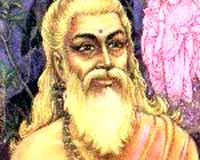 Early Life
Early Life
Rishi Vishwamitra was born as 'Kaushika' and was the great-grandson of a great
sage king, known as Kusha. He was born to Gadhi, one of the four sons of
Kusha. Like every other prince, Kaushika also succeeded his father to the
throne of his kingdom.
Meeting Sage Vasishta
While on a tour of his kingdom, Kaushika came across the hermitage of the
great sage, Vasishta, along with his army. The peace and the solitude
surrounding the hermitage impressed him deeply and he entered inside. There,
he and his army were well received and served a splendid feast. Surprised at
the welcome received by him, Kaushika asked sage Vasishta that how he managed
to feed such a large army.
The sage replied that the food was provided to him by his calf, Nandini,
gifted to him by Lord Indra himself. Kaushika offered the sage a large amount
of wealth in return of the calf. However, the sage declined the offer. Enraged
at the refusal of sage Vasishta, he ordered his army to forcefully take the
calf to his kingdom. The sage used his yogic powers to bring forth a huge
militia of fierce warriors, who defeated the army of Kaushika. Kaushika was
captured and brought before the sage, who pardoned him.
Renunciation
The above mentioned incident deeply affected Kaushika and made him realize
that power of penance was greater than that of physical strength. He
relinquished his throne and began his journey to become a sage, greater than
even Vasishta. After undergoing intense meditation and severe asceticism, he
was bestowed with the title of Brahmarishi by Lord Brahma himself. He was
given the name of 'Vishwamitra' (friend of all).
Legends surrounding Vishwamitra
It is said that Sage Vishwamitra created a parallel heaven, known as Trishanku
Swarga, for King Trishanku. It is also believed that in the great epic
Ramayana, Vishvamitra was born as Lakshmana, the brother of Lord Rama. He gave
his brothers the knowledge of the Devastras (celestial weaponry), trained them
in advanced religion and taught them how to kill powerful demons.
Surdas
About Surdas
Surdas is one of the people who had great influence on the cultural heritage
of India. He was a poet, a saint and a musician and played all the parts with
the same finesse. Since there are no authentic records on the life of Surdas,
his biography comes up as a combination of facts and fiction.
Early Life
There is a little disagreement regarding the exact birth date of Surdas, some
scholars believe it to be 1478 AD, while others believe it to be 1479 AD. Same
is the case of the year of his death, it is either considered to be 1581 AD or
1584 AD. As per the limited authentic life history of Surdas, it is said that
he lived in Braj, near Mathura. Surdas was born blind and because of this, he
was neglected by his family. As a result, he left his home at tender age of
six.
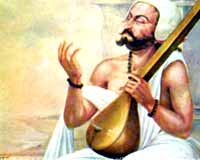 Meeting Shri Vallabharacharya
Meeting Shri Vallabharacharya
In the eighteenth year of his life, Surdas went to Gau Ghat, a sacred bathing
spot on the embankments of Yamuna River. It was here that he came across Shri
Vallabharacharya, the great saint-savant. Vallabharacharya advised Surdas to
sing Bhagvat Lila, the Creative Play of the Lord and introduced him to the
secrets of contemplative devotion. From this time onwards, Surdas never looked
back on the path of spirituality. Surdas spent the last years of his life in
Braj, the place of his birth.
Literary Works of Surdas
The work of Surdas mainly consists of the following three compilations.
Sur-Saravali
Sur-Saravali, based on the festival of Holi, originally consisted of hundred
verses. In this poem, he tried to create a theory of Genesis, with Lord
Krishna as the Creator.
Sahitya-Lahiri
Sahitya-Lahiri is mainly associated with Bhakti (devotion) towards the Supreme
Lord.
Sur-Sagar
Sur-Sagar is considered to be the magnum opus of Surdas. The poem has been
woven around the life of Lord Krishna. It originally contained 100,000 poems
or songs, out of which only 8000 have survived the travails of time.
Philosophy of Surdas
The Bhakti movement that was widely prevalent in India at the time of Surdas
deeply affected him. He propagated the Shuddhadvaita school of Vaishnavism. It
makes use of the spiritual metaphor of the Radha-Krishna Lila, derived from
earlier saints.
Swami Vivekananda
About Swami Vivekananda
Swami Vivekananda was the disciple of Ramakrishna Paramahansa. He founded
the Ramakrishna mission to spread the teachings of his Guru throughout the
world. One of the most famous and influential spiritual leaders of India, he
sought to promote the philosophies of Vedanta and Yoga. Swami Vivekananda
was the first spiritual leader of India who introduced Hinduism, Yoga and
Vedanta at the World's Parliament of Religions. Read this biography further
to know more about Swami Vivekananda, his teachings and his life history.
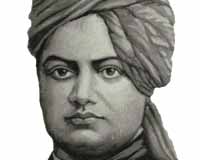 Early Life
Early Life
Swami Vivekananda was born as Narendranath Dutta in Calcutta (now Kolkata),
in the year 1863. Even as a child, Narendra showed a high level of
intelligence and a deep inclination towards meditation. He joined Presidency
College of Calcutta in 1879 for one year and then entered Scottish Church
College to study philosophy. By this time, Narendra started questioning God
and His presence. He also became a part of the Brahmo Samaj, a religious
movement. Unsatisfied with only congregational prayers and devotional songs,
he started looking elsewhere to find answers to his questions.
Meeting Ramakrishna and Renunciation
His search led Narendra towards Ramakrishna, whom he met in November 1881.
After testing Ramakrishna to his maximum limit, Narendra accepted him
wholeheartedly as his Guru. He remained with Ramakrishna for a period of
five years. After the death of his Guru, Narendra took his vows as a monk,
renounced the world and became Swami Vivekananda. In July 1890, Narendra
started his journey as a wanderer, roaming around the country promoting the
teachings of his Guru.
Ramakrishna Mission
Swami Vivekananda established the Ramakrishna Mission to spread the
teachings of his Guru, Ramakrishna, far and wide. He left for the holy abode
in 1902, at the Belur Math, near Calcutta.
Swami Vivekananda Teachings
-
Each individual is himself responsible for making or breaking his life.
He should concentrate on his goal and should not rest until it is achieved.
-
God in Nirankar (formless), with attributes.
-
God is one and different religions serve as a path towards the same God.
-
God is present in every living being and he, who serves others, serves
God.
-
Human being should strive towards truth, purity, sincerity, morals and
unselfishness.
-
The quintessence of every religion is to make people realize the highest
spiritual truth.
-
To be good and to do good is the main aim of every individual.
Swami Satyananda Saraswati
About Swami Satyananda Saraswati
Swami Satyananda Saraswati belonged to the Dashnami lineage of Adi
Shankaracharya. He is one of the members of the tribe of Swamis who are
called for the order of "Saraswati". In the other words, he is one of the
sanyasi-scholars, who live the life of a Brahmin and believe in both
knowledge and devotion. Paramahamsa Satyananda Saraswati is one of the most
famous Yoga Gurus, not only in India, but also in the West. Get to know more
about the guru with this biography.
His Life History
Swami Satyananda Saraswati was born in the year 1923, in Almora town of
Uttar Pradesh. At the tender age of six, Satyananda started having
spontaneous psychic and spiritual experiences. During such events, he used
to become completely unaware of his body for quite a long time. By the time
he reached fifteen years of age, Satyananda started practicing Kundalini
Yoga. In another two years, he began asking complex questions like 'what is
the difference between perception and experience?'
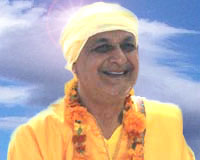 At
nineteen years, he decided to find a Guru who would guide him towards the
highest state of consciousness and left his house in this pursuit. It was in
the year 1943 that he met Yoga Master Swami Sivananda Saraswati in Rishikesh
city of Uttar Pradesh and his search came to an end. He stayed with the Guru
for a period of three years. Thereafter, he was initiated by Sivananda
Saraswati into the Dashnami order, as a Poorna as well as a Paramahamsa
Sanyasi. He was then given the name of 'Swami Satyananda Saraswati'. At
nineteen years, he decided to find a Guru who would guide him towards the
highest state of consciousness and left his house in this pursuit. It was in
the year 1943 that he met Yoga Master Swami Sivananda Saraswati in Rishikesh
city of Uttar Pradesh and his search came to an end. He stayed with the Guru
for a period of three years. Thereafter, he was initiated by Sivananda
Saraswati into the Dashnami order, as a Poorna as well as a Paramahamsa
Sanyasi. He was then given the name of 'Swami Satyananda Saraswati'.
Paramahamsa Satyananda completed his initial sanyas training of twelve years
in the year 1956. This was followed by his initiation into Kriya Yoga, again
by Swami Sivananda. Thereafter, he began to practice Parivrajaka (Mendicant)
stage of sanyasa. During this period, Swami Satyananda Saraswati traveled
all over the Indian subcontinent. This travel helped him in meeting numerous
saints of that time as well as knowing the needs of the society. Swamiji
spent years in seclusion, practicing and perfecting his Yoga Sadhana.
Swami Satyananda Saraswati went on his first World Tour in 1968, under the
guidance of his Guru. This was followed by several international and
national tours, to promote the teaching of yoga. In July 1963, after Swami
Sivananda Saraswati passed away, Swami Satyananda established the
headquarters of his mission in Munger city of Bihar. In the subsequent
years, he set up the Bihar School of Yoga, International Yoga Fellowship
Movement, Sivananda Math and the Yoga Research Foundation.
Recognition
In 1973, Paramahamsa Satyananda Saraswati was recognized as an Adept (God
realized Yogi). The International Yoga Convention was held to commemorate
the Sanyasa Golden Jubilee renunciation of Swami Sivananda. It was here that
the renowned saints and sages of India accepted him as one of the principal
experts in the filed of esoteric knowledge as well as the leading proponent
of Yoga.
In the years that he devoted to Yoga teaching, Swami Satyananda Saraswati
mastered over eighty masterful Yoga texts. He renounced teaching, in 1988,
to take up the lifestyle of a Paramahamsa. After settling in the small
village of Rikhia, he has been leading a life of meditative seclusion.
Today, he involved in the practice of the severest of the Vedic Sadhanas,
such as the Panch Agni Sadhana. He still meets people once in a year, for
few weeks, to share his radiance of truth with them.
Works
-
Founded 'Sri Panch Dashnam Paramahamsa Alakh Bara' at Rikhia (1900)
-
Inaugurated 'Raj Sooya Yajna', an ancient Vedic ceremony (2001)
Sadhguru Jaggi Vasudev
About Sadhguru Jaggi Vasudev
Sadhguru Jaggi Vasudev is a world-renowned mystic and yogi of Indian origin.
The founder of Isha Yoga as well as of Isha Foundation, he is also a very
famous poet. His aim in life is to help people in manifesting their own
spirituality. Sadhguru Jaggi Vasudev has several yoga centers, set up in the
various cities of India as well as the United States. He was a delegate to
the United Nations Millennium World Peace Summit and even participated at
the World Economic Forum in 2006 & 2007. Read this biography to know more
about the guru.
His Life History
Sadhguru Jaggi Vasudev was born in Mysore city of India, to a physician
father. Right from childhood, Vasudev was quite different from the others.
At the tender age of thirteen years, he started yogic practices, like
Pranayams and Asanas, under the guidance of Shree Raghavendra Rao
(Malladihalli Swami). He completed his graduation from the Mysore University
of Karnataka. When Vasudev was twenty-five years old, he witnessed an
unusual incident that led him away from the material things in life and
towards renunciation.
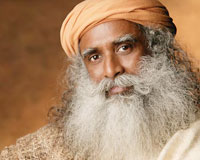 One
afternoon, Sadhguru Jaggi Vasudev went to the Chamundi hills and sat on a
rock with his eyes wide open. Suddenly, he had an out of body experience. He
felt as if he was not in his body anymore, rather spread out everywhere, in
the rocks, in the trees, in the earth. By the time he came back to his
senses, it was already evening. In the days that followed, Vasudev
experienced the same situated again, a number of times. Whenever, he
underwent such an experience, he went without food and sleep for the next
three or four days. One
afternoon, Sadhguru Jaggi Vasudev went to the Chamundi hills and sat on a
rock with his eyes wide open. Suddenly, he had an out of body experience. He
felt as if he was not in his body anymore, rather spread out everywhere, in
the rocks, in the trees, in the earth. By the time he came back to his
senses, it was already evening. In the days that followed, Vasudev
experienced the same situated again, a number of times. Whenever, he
underwent such an experience, he went without food and sleep for the next
three or four days.
This episode entirely changed his way of life. Jaggi Vasudev decided to
dedicate his entire life to the sharing of those experiences. In the year
1992, the guru and his followers founded the Isha Yoga Center and Ashram. It
is situated at the foothills of the sacred Velliangiri Mountains at Poondi,
near Coimbatore. The center is spread over an area of 50 acres and houses a
massive 13 ft Dhyanalingam, a meditation shrine. There is also a
multi-religious temple inside the complex, which was completed in 1999.
It is said that the Dhyanalingam has curative powers and bestows well being
and prosperity. Since it is a meditation shrine, it is believed to be
reservoir of energies from the people who have meditated there. People can
sit inside the Dhyanalingam and meditate for as much time as they want. Isha
Yoga Center also houses the Isha Foundation. Started by Sadhguru Jaggi
Vasudev, the foundation administers more than 25 yoga centers, a medical
center and an orphanage in India, apart from three yoga centers in the
United States.
Isha Yoga
Isha Yoga is basically a form of science, which is subtle yet very powerful.
It is based on the principle in which the body is believed to be the temple
of the spirit. At the same time, good health is considered as fundamental to
physical as well as spiritual development. The main aim of Isha Yoga is to
cultivate and promote best possible health, along with peace and calmness.
It intends to assist the natural process of unfolding in each and every
person. The inner chemistry of a person is changed to release the physical,
mental and emotional blocks.
Sri K. Pattabhi Jois
About Sri K. Pattabhi Jois
Sri K. Pattabhi Jois, or Sri Krishna Pattabhi Jois, counts amongst the
world-renowned yoga teachers of India. A student of Sri Tirumalai
Krishnamacharya, he is currently teaching at the Ashtanga Yoga Research
Institute of Mysore, founded by him. His yoga shala attracts thousands of
foreign students every year. Let us move on further to explore the complete
biography of Sri K. Pattabhi Jois.
His Life History
Sri K. Pattabhi Jois was born as Krishna on 26th July 1915 in the village of
Kowshika, situated near Hassan city of Karnataka. It was at the age of
twelve years that Krishna realized his aim in life. In his twelfth year
i.e., 1927, he attended a lecture and demonstration given by S. T.
Krishnamacharya in the Hassan city. Pattabhi Jois got so impressed by the
lecture that, on the very next day, he became Krishnamacharya's student and
continued his study for the next twenty-five years.
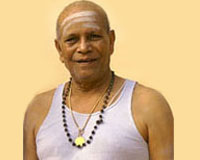 In
the year 1929, Jois ran away from his home and went to Mysore, in order to
study Sanskrit. By coincidence, Krishnamacharya also left Hassan to teach
somewhere else. Somehow, he also made his way to Mysore and met Jois once
again after a gap of two years. During this time, Krishnamacharya had cured
Maharaja of Mysore, Krishna Rajendra Wodeyar, of a very seriously illness.
As an expression of his gratitude, the Maharaja had established a Yoga shala
for him on the palace grounds. In
the year 1929, Jois ran away from his home and went to Mysore, in order to
study Sanskrit. By coincidence, Krishnamacharya also left Hassan to teach
somewhere else. Somehow, he also made his way to Mysore and met Jois once
again after a gap of two years. During this time, Krishnamacharya had cured
Maharaja of Mysore, Krishna Rajendra Wodeyar, of a very seriously illness.
As an expression of his gratitude, the Maharaja had established a Yoga shala
for him on the palace grounds.
Sri K. Pattabhi Jois remained with his Guru until 1941, when he left for
Madras. However, Jois continued staying in Mysore afterwards and married a
young woman named Savitramma (popularly known as Amma), with whom he fell in
love. The marriage took place in June 1937 and they were later blessed with
three children Saraswati, Manju and Ramesh. In 1948, Sri K. Pattabhi Jois
managed to buy a home in a section of town, called Lakshmipuram, with the
help of his students.
After buying the house, he established the 'Ashtanga Yoga Research
Institute' there. Jois taught yoga at the Sanskrit College for a number of
years and became a professor in 1956. In 1958, he started writing Yoga Mala,
which was published in India in 1962. The first English version of the book
came out in 1999. Even today, Jois teaches yoga, with his daughter Saraswati
and his grandson Sharath, at the Ashtanga Yoga Research Institute, which is
now located in the neighborhood of Gokulum.
Swami Yogeshwaranand Saraswati
About Swami Yogeshwaranand Saraswati
Swami Yogeshwaranand Saraswati was counted amongst the most popular as well
as most learned Yogis of the 20th century. His life, which was spent mostly
in the Himalayas, is the perfect example of extreme renunciation and
asceticism. Yogeshwaranand devoted himself completely towards the
realization of the soul and God. He was a major proponent of yoga and aimed
at reviving the ancient science. With this biography, you will be able to
know more about Swami Yogeshwaranand Paramahansa.
His Life History
Swami Yogeshwaranand Saraswati was born as Brahmachari Vyas Dev ji, to
extremely rich parents. However, he left his home at the tender age of
twelve, in search of knowledge and self-realization. His entire youth was
spent in studying Sanskrit language and mastering the scriptural knowledge.
Some time later, he went to the Himalayas and practiced the most difficult
tapasya and yogic sadhana. All the while, he was in the search of a guru,
who could help him in attaining his goal.
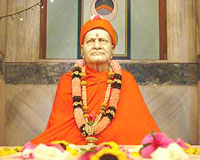 In
the process, he came across Yogi Paramananda Avadhoot, a great ascetic who
helped him in perfecting shunya (void) samadhi. However, his search for a
real guru ended when he met Avadhoot Swami Atmanand ji in a cave near
Gangotri (in Himalayas). From Atmanand ji, he got to learn Samprajnata
samadhi and awareness of various processes of nature in the state of
samadhi, the ultimate divine knowledge. Throughout his life, he kept meeting
great ascetics, learned from them and attained higher stages in yoga and
meditation. In
the process, he came across Yogi Paramananda Avadhoot, a great ascetic who
helped him in perfecting shunya (void) samadhi. However, his search for a
real guru ended when he met Avadhoot Swami Atmanand ji in a cave near
Gangotri (in Himalayas). From Atmanand ji, he got to learn Samprajnata
samadhi and awareness of various processes of nature in the state of
samadhi, the ultimate divine knowledge. Throughout his life, he kept meeting
great ascetics, learned from them and attained higher stages in yoga and
meditation.
Some of the Samadhis of Swami Yogeshwaranand Saraswati lasted for several
weeks. In the end, he used to wake up with advanced knowledge of
self-realization, origin & conclusion of cosmos and the objective of human
existence. Throughout his life, he imparted his knowledge to people
belonging to different faiths as well as different countries. Swami
Yogeshwaranand Paramahansa also traveled abroad to spread knowledge. He
breathed his last on 23rd April 1985, at the age of ninety-nine.
Tukaram
About Sant Tukaram
Tukaram was one of the greatest poet saints ever born in India. It is quite
renowned for his contribution to the Bhakti Movement of Maharashtra. Read
this biography further to know more about the Sant Tukaram.
Early Life
The exact records related to the life history of Tukaram are not available.
So, there is a little disagreement regarding his exact birthdate. It is
considered to be one of the four - 1568 AD, 1577 AD, 1608 AD or 1598 AD. He
was born in Dehu, near the Pune city to a trader father. He was married
twice. His first wife died of starvation, during a period of severe famine.
While, his second wife constantly nagged him for not being able to properly
support his family.
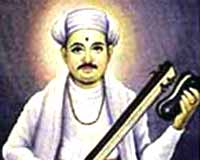 Enlightenment
Enlightenment
Tortured by the death of his first wife, the constant nagging of the second
and the failure in his spiritual quest, Tukaram went into a severe
depression. By the age of twenty-one, he had lost all the hopes in life and
was at the threshold of death. At this point of time, he had a dream, in
which one Babaji Chaitanya initiated him into the spiritual path. That
particular moment changed his destiny and he started his journey as one of
the best poet saints of the country.
Teachings of Sant Tukaram
-
An individual should make God the center of his universe. Serving others
and loving others is the best way through which we can find Him.
-
For the attainment of sadhana, an individual needs to have faith in
his/her destiny.
-
It is not necessary to renounce the world and lead the life of an
ascetic in order to be one with God. Spirituality does not require elaborate
rituals.
-
Nama Japa (reciting the name of Lord) is the most important privilege of
being a devotee.
-
Siddhis serve as impediments in the attainment of genuine sadhana
(meditation).
-
Traditions prevent an individual from budding in the love of God. One
has to sidestep the usual customs to achieve the same.
Shri Yogendra
About Shri Yogendra Shri Yogendra was the founder of 'The Yoga
Institute' situated in Santa Cruz, Mumbai. A firm believer of yoga, he founded
the institute to promote the science of Yoga throughout the world. He was also
credited with the revival of the classical yoga ideals. Read this biography
further to know more about Shri Yogananda.
His Life
The life history of Sri Yogendra tells us that he was born on 18th November
1897. When his met Guru Paramahamsa Madhavadasaji, he was still in college.
The meeting with Paramahamsa Madhavadasaji made Yogendra a devoted believer of
Yoga. He joined Paramahamsa Madhavadasaji's ashram in Malsar city of Gujrat
and started studying Yoga sincerely. After completing his training, he decided
to leave the ashram, in order to propagate the benefits of Yoga amongst the
masses. Shri Yogendra left the world in 1989, passing on his legacy to his
son, Dr. Jayadev.
Establishment of 'The Yoga Institute'
Shri Yogendra was also a brilliant poet. Mr. Masani, an influential person
from Mumbai, once came across is poetry. Impressed with Shri Yogendra, he
invited him to his home in Versova, Mumbai. Mr. Masani offered him his own
house as an ashram. This laid the foundation of The Yoga Institute of Mumbai.
About The Yoga Institute
One of the oldest organized Yoga enters in the world, The Yoga Institute of
Mumbai is a non-profit organization. It aims at helping people in physical,
moral and psychic development, with yoga as an aid.
Swami Sivananda
About Swami Sivananda
Swami Sivananda was a responsible for promoting the philosophy of Yoga and
Vedanta amongst the people of India as well as the world. He was also the
founder of the Divine Life Society, apart from being the author of more than
200 books, on Yoga, Vedanta, etc. read on this biography to know more about
Swami Sivananda and his life history.
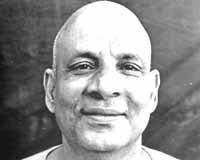 His Early Life
His Early Life
Swami Sivananda was born as Kuppuswamy on 8th September 1887, in Pattamadai,
Tamil Nadu. The third son of his parents, Kuppuswamy displayed great
intelligence right from his childhood. While completing his medical studied
from Tanjore, he started a medical journal called Ambrosia. After graduating
in medicine, he started practicing in Malaysia for a prod of ten years. He
always used to treat the poor people free of cost.
As time passed, he started feeling that medicine cured a person only at a
superficial level, without even touching their soul. People are affected by
problems only at a physical level, but also at the spiritual level. His
spiritual quest made him leave Malaysia in 1923 and come back to India.
Meeting Swami Vishwananda Saraswati and Initiation
After coming to India, Kuppuswamy started visiting various pilgrimage
destinations. He met Swami Vishwananda Saraswati in Rishikesh in 1924 and
took him as his Guru. Vishwananda initiated him into sanyas (asceticism) and
gave the name of Swami Sivananda. However, Swami Vishnudevananda, the Mahant
of Sri Kailas Ashram, performed the rest of the Viraja Homa ceremonies
later. In 1927, Sivananda started a charitable dispensary at Lakshmanjula,
where he treated pilgrims, holy men and the poor. Swami Sivananda left the
world on 14 July 1963, on the bank of Ganges, in Shivanandanagar.
Foundations set up by Swami Sivananda
-
Divine Life Society (1936)
-
Sivananda Ayurvedic Pharmacy (1945)
-
All-world Religions Federation (1945)
-
All-world Sadhus Federation (1947)
-
Yoga-Vedanta Forest Academy (1948)
Swami Sivananda Yoga
Sivananda Yoga is a type of Hatha Yoga, which lays stress on asanas
(postures), savasana (relaxation), pranayama (proper breathing), diet
(vegetarian) and Vedanta and dhyana (positive thinking and meditation).
Sri Sri Ravi Shankar
About Sri Sri Ravi Shankar
Sri Sri Ravi Shankar is a famous spiritual leader of India. He is credited
with being the initiator of a foundation, known as the Art of Living
Foundation. His aim in life is to teach people cope up with the stresses of
everyday life and be at peace with themselves. He is also the founder of a
number of charitable organizations, like the International Association for
Human Values. Read this biography on Sri Sri Ravi Shankar further, to know
more about him and his life history.
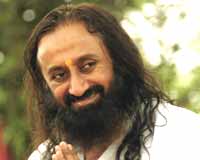 His Life
His Life
Sri Sri Ravishankar was born in 1956 in the southern part of India. It is said
that at the tender age of four, he could recite parts of the scared Bhagwad
Gita. By time he was 17 years old, he had already attained an advanced degree
in Modern Physics. Some time later, he received an Honorary Doctorate from
Kuvempu University of India. Other than that, there is very little information
on the childhood and the early life of Sri Sri Ravishankar.
Receiving Enlightenment
It is believed that Sri Sri Ravi Shankar received Enlightenment in the year
1982. He had retreated into silence and on the tenth day of his silence, he
became Enlightened. Enlightenment also bestowed Ravi Shankar with the
technique of Sudarshan Kriya, a rhythmic breathing exercise.
Establishing Art of Living Foundation
In 1982, the year he received Enlightenment, Sri Sri Ravi Shankar established
the Art of Living Foundation. Thorough this foundation, he promoted the
Sudarshan Kriya. Today, his foundation is considered to be one of the largest
volunteer-based educational and humanitarian organizations in the world. In
1997, he founded the International Association for Human Values (IAHV), along
with Dalai Lama and a number of other people.
Philosophy of Sri Sri Ravi Shankar
Sri Sri Ravi Shankar teaches people to replace hatred and suffering with love
and wisdom. He spreads the message of universal love, peace and brotherhood
throughout the world. He aims at promoting spirituality amongst people and
making them realize that there is goodness in every individual. He advises
people to accept as well as respect each other.
Patanjali
About Patanjali
It is believed that Maharishi Patanjali was the avatar of Adi Shesha - the
Infinite Cosmic Serpent upon whom Lord Vishnu rests. He is considered to be
the compiler of the Yoga Sutras, along with being the author of a commentary
on Panini's Ashtadhyayi, known as Mahabhasya. He is also supposed to be the
writer of a work on the ancient Indian medicine system, Ayurveda. Read on this
biography further to know more about Maharishi Patanjali and his philosophy.
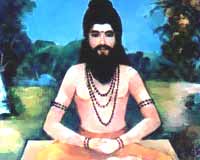 His Life
His Life
The life history of Patanjali is full of legends and contradictions. There are
no authentic records regarding his birth. As per one legend, he fell (pata)
into the hands (anjali) of a woman, thus giving him the name Patanjali.
Patanjali Yoga Sutras
It is said that once, while watching a dance by Lord Shiva, Adi Shesha found
it unbearable to support the weight of Lord Vishnu. Amazed at this, he asked
Lord Vishnu the reason for the same. Lord Vishnu said that this was because of
his harmony with Lord Shiva's energy state, owing to the practice of Yoga.
Realizing the value and benefits of Yoga, Adi Shesha decided to be born
amongst humans as 'Patanjali', to teach them the great art.
Yoga Sutras are considered to serve as the basis of the yogic techniques.
Maharishi Patanjali, "The Father of Yoga", compiled 195 sutras, which serve as
a framework for integrating Yoga into the daily routine and leading an ethical
life. The exact date of the compilation of the Yoga Sutras is not known.
However, it is believed that they were written somewhere around 200 BC. The
core of Patanjali's teachings lies in the eightfold path of yoga. The path
shows the way to live a better life through yoga.
Adi Shankaracharya
About Adi Shankaracharya
Adi Shankaracharya was the first philosopher who consolidated Advaita Vedanta,
one of the sub-schools of Vedanta. He believed in the greatness of the holy
Vedas and was a major proponent of the same. Not only did he infuse a new life
into the Vedas, but also advocated against the Vedic religious practices of
ritualistic excesses. He founded four Shankaracharya Peethas in the four corners
of India, which continue to promote his philosophy and teachings. Adi
Sankaracharya biography reveals that he was also the founder of Dashanami
monastic order and the Shanmata tradition of worship.
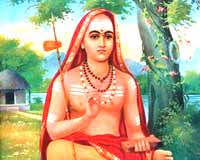 Childhood of Adi Shankaracharya
Childhood of Adi Shankaracharya
Adi Shankaracharya was born as Shankara in around 788 AD in a Brahmin family
in Kaladi village of Kerala. He was born to Sivaguru and Aryamba a number of
years after their marriage. It is said that Aryamba had a vision of Lord
Shiva, in which he promised her that He would incarnate Himself in the form of
her first-born child. The life history of Adi Shankracharya tells us that he
showed great intelligence right from his childhood. He mastered all the Vedas
and the Vedanta in gurukul itself and could recite the epics and Puranas by
heart.
Adopting Sanyasa (Monastic Life)
Adi Shankaracharya was attracted towards sanyasa right from his childhood. One
day, while bathing in the Purna River, Shankaracharya was attacked by a
crocodile. Seeing his mother's incapability to rescue him, he asked her to
give him the permission to renounce the world. Left with no other option, she
agreed to it. Shankaracharya recited the mantras of renunciation and
immediately, the crocodile left him. Thus started the life of Shankara as an
ascetic. He left Kerala and moved towards South India in search of a Guru.
Meeting Govinda Bhagavatpada and Enlightenment
On the banks of Narmada River, Shankara met Govinda Bhagavatpada. Impressed by
his knowledge of the Vedas and the Vedanta, he took Shankaracharya under his
tutelage. Under the guidance of his Guru, Shankara mastered Hatha, Raja and
Jnana Yoga. Thereafter he received initiation in the knowledge of Brahma. Thus
was born Adi Shankaracharya, whose aim in life was to spread the Vedic
teachings of the Brahma Sutras throughout the world.
Adi Sankaracharya Teachings
The philosophy and teachings of Adi Sankaracharya were based on the Advaita
Vedanta. He preached 'Non-Dualism'. It means that each and every person has a
divine existence, which can be identified with the Supreme God. The mere
thought that human being is finite with a name and form subject to earthly
changes, is to be discarded. The bodies are diverse, but the soul of all the
separate bodies is the same, the Divine One.
The Four Adi Shankaracharya Peethas
-
Vedanta Jnana Peetha, Sringeri (South India)
-
Govardhana Peetha in Jagannath Puri (East India)
-
Kalika Peetha, Dwaraka (West India)
-
Jyotih Peetha, Badarikashrama (North India)
Andal
About Andal
Andal was a 10th century Tamil poet who is revered as a saint in the southern
parts of India. Infact, she is considered as one of the twelve Alvars (saints)
and the only woman Alvar (saint) of Vaishnavism (a cult devoted to Lord Vishnu).
She is also believed to be an incarnation of Sri Bhumi Devi, the Divine Consort
of Sriman Narayana (a manifestation of Lord Vishnu). Andal Thiruppavai, the
compilation of devotional poems sung by her, is still recited by devotees during
the month of Margazhi.
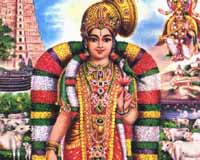 Early Life
Early Life
The life history of Andal tells us that a person named Vishnucitta found her, as
a little baby girl, under a Tulsi plant in the temple garden of Srivilliputtur.
He gave her the name of Goda, meaning 'the gift of Earth'. Vishnucitta brought
her up in an atmosphere of love and devotion towards the Lord. The intensity of
her love and dedication towards the Lord grew so much that she decide to marry
Sri Ranganatha, a form of Lord Vishnu.
Unusual Offering
As per Andal biography, as she grew, her determination to marry Lord Ranganatha
also increased. She also started making a unique offering to the Lord. She used
to wear a flower garland first herself and then offer it to God. As an
explanation, she said that first wanted to see whether the garland looked good
or not by wearing it herself and looking in the mirror. Only after she was
convinced that the garland looked nice, did she offer it to God.
One day, her father saw her doing this and admonished her from repeating this
act. Goda made a new garland for the Lord. It is said that the same night,
Vishnucitta received a vision from the Lord, who told him that He heartily
accepted Goda's offerings. From that day onwards, Goda came to be known as "Andal",
the girl who "ruled" over the Lord.
Marrying the Lord
As Andal reached the marriageable age of 15, her father asked her to get
married. She replied that she would marry only Sri Ranganatha. It is believed
that after this incident, Vishnucitta again received a divine vision, in which
the Lord instructed him to send Andal to Sri Ranganatha Temple. At the same
time, the priests at Sri Ranganatha Temple also received a vision where the Lord
ordered them to prepare for the marriage. It is said that after reaching Sri
Ranganatha Temple, Andal married the Lord.
Andal Thiruppavai and Nacciyar Tirumoli
Andal composed two poetic works in her lifetime, both in Tamil. Even though she
compiled the poems in her teenage years, they display a high level of literary
and religious maturity. Her first work is known as Andal Thiruppavai. It is
compilation of thirty verses, in which she imagines herself to be a cowherd girl
who longs to serve Lord Krishna. The second compilation is known as Nacciyar
Tirumoli, consisting of 143 verses. Through this poem, she disclosed her
passionate yearning for Lord Vishnu.
Bharat Thakur
About Bharat Thakur
Bharat Thakur is one of the spiritual masters of India who have received
international recognition. The founder of Artistic Yoga, he has numerous
meditation workshops to his credit. He also conducts yoga training-sessions
for groups and individuals, along with corporate yoga workshops, throughout
the world. Bharat Thakur has opened yoga studios or yoga centers in various
cities, like Delhi, Mumbai, Chennai, Bangalore, Moscow and Dubai. You can know
more about his biography with this article.
His Life History
Bharat's parents remained childless for many years after their marriage.
Distressed, they sought the blessings of Guru Sukhdev Brahmachari. However,
the guru kept a precondition that he would keep their eldest child under his
care, for a couple of years. They agreed to this and soon after being blessed
by the Guru, the wife gave birth to Bharat Thakur, followed by three more
children. Guru Sukhdev Brahmachari took Bharat away from his family at the
tender age of four.
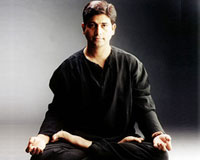 Both
of them went to the Himalayas, where the boy stayed for the next ten years.
Guru Sukhdev, a Sufi fakir sent him to learn from different gurus, like Sufi,
Buddhist and Hindu. Under these gurus, he learnt as well as mastered Ayurveda,
Tantra, Mantra, Sufism, Jainism and Buddhism. Thereafter, Bharat Thakur
studied different forms of Yoga, like Hatha Yoga, Ashtanga Yoga, Karma Yoga
and Kundalini Yoga, under Guru Sukhdev. Both
of them went to the Himalayas, where the boy stayed for the next ten years.
Guru Sukhdev, a Sufi fakir sent him to learn from different gurus, like Sufi,
Buddhist and Hindu. Under these gurus, he learnt as well as mastered Ayurveda,
Tantra, Mantra, Sufism, Jainism and Buddhism. Thereafter, Bharat Thakur
studied different forms of Yoga, like Hatha Yoga, Ashtanga Yoga, Karma Yoga
and Kundalini Yoga, under Guru Sukhdev.
He also perfected other elements like Pranayama (breathing techniques), Asanas
(postures) and Dhyana (meditation). After he came back from the Himalayas, he
completed his education. He did his graduation and then his post-graduation in
Exercise Physiology and Yoga in Gwalior, from the Lakshmibai National College
of Physical Education. Presently, he conducts workshops, group classes as well
as private classes in his numerous yoga centers.
Books
Bharat Thakur has written seven books, namely 'Yoga For All', 'Yoga For Stress
Relief', 'Yoga For Weight Loss', 'Yoga For Family', 'Yoga for Flat Abs' and
'Yoga for Backache Relief'. He is also the composer of a collection of the
poetry, "Truth: The Art of The Mystics".
Artistic Yoga
Bharat Thakur is the founder of a new form of Yoga, known as the Artistic
Yoga. It is a unique, experimental and powerful system of yoga, which makes
use of ancient yogic techniques like asanas, pranayama, bandhas, kriyas, etc.
This form of yoga concentrates on each and every aspect of a human being,
right form the physical to the spiritual.
The physical aspect works on flexibility, vigor and stamina. The spiritual
aspect, on the other hand, works upon awareness of the body, alertness and
meditation. It brings about a complete transformation in a human being and
leads to stress relief, weight loss, body toning and gastric relief.
Alleviation of backache and an increase in energy level are its other
benefits.
Bikram Choudhary
About Bikram Choudhury
Bikram Choudhury, the founder of Bikram Yoga, is one of the most popular
fitness gurus in Hollywood. He is also the founder of the worldwide Yoga
College of India. With this biography, you will get to know more about Bikram
Choudhary as well as Bikram yoga.
His Life History
Bikram Choudhury was born in the city of Calcutta (now Kolkata), in the year
1946. He was introduced to the technique of yoga at the tender age of four
years only. Bikram underwent yoga training under Bishnu Ghosh, one of the most
popular physical culturists of that time, at his 'College of Physical
Education'. Bishnu is the younger brother of Paramahansa Yogananda (Author of
'The Autobiography of a Yogi' and founder of the Self-Realization Fellowship
in Los Angeles).
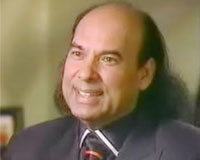 Bikram
practiced yoga rigorously, devoting four to six hours every day towards it.
When he was only thirteen years old, he won the National India Yoga
Championship and kept claiming the title for the next three years also.
Thereafter he retired as the undisputed 'All-India National Yoga Champion'. At
the age of seventeen years, Bikram Choudhury got badly injured in the knee
during a weight-lifting accident. Renowned doctors, from as far as Europe,
gave up the chances of his ever walking again. Bikram
practiced yoga rigorously, devoting four to six hours every day towards it.
When he was only thirteen years old, he won the National India Yoga
Championship and kept claiming the title for the next three years also.
Thereafter he retired as the undisputed 'All-India National Yoga Champion'. At
the age of seventeen years, Bikram Choudhury got badly injured in the knee
during a weight-lifting accident. Renowned doctors, from as far as Europe,
gave up the chances of his ever walking again.
However, having faith in his teacher, Bishnu Ghosh, and his yoga techniques,
Bikram went back to his school. Six months later, he experienced total
recovery in his knee. Thereafter, Bishnu asked Bikram Choudhary to start a
number of Yoga schools in India. Bikram received fantastic response from
people and his yoga schools become extremely successful. Then, again at
Bishnu's insistence, Bikram traveled to Japan and opened two yoga schools.
Since that time, he has being promoting the curative techniques of Yoga
therapy around the world.
Bikram Yoga
Bikram Choudhury introduced a new style of yoga, known as the Bikram Yoga or
Hot Yoga. This style is practiced in a room that has been preheated to a
temperature of 105 deg F (40.5 deg C) and has a humidity of 50 percent. The
training course goes on for nine weeks, during which the temperature is slowly
taken to, as high as, 130 deg F. The entire course involves the training of 26
postures and two breathing exercises.
BKS Iyengar
About BKS Iyengar
The full name of BKS Iyengar, one of the most renowned yoga gurus in the whole
world, is Belur Krishnamachar Sundararaja Iyengar. Popularly known as
Yogacharya B.K.S. Iyengar, he is man who founded the Iyengar Yoga. The guru
has been teaching people the art of yoga since the past sixty years and at the
same time, is the author of numerous books on yogic practice and philosophy,
along with several definitive yoga texts.
His most popular books include 'Light on Yoga', 'Light on Pranayama' and
'Light on the Yoga Sutras of Patanjali'. The majority of credit for the
introduction of yoga in the west goes to Sri BKS Iyengar only. One can find
Iyengar yoga centers even in the remotest corners of the world. Today, the
great man is over 80 years old and still stands as strong as ever. With this
biography, you will get a brief introduction on BKS Iyengar.
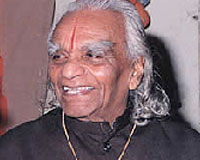 His Life History
His Life History
Sri B.K.S. Iyengar was born on 14th December 1918 in the Belur district of
Karnataka. He faced difficulties in the early stages of life itself. Iyengar
was born into a large poor family and immediately after his birth; he fell in
the grips of an influenza epidemic that left him totally frail and unhealthy.
Then, the poor boy lost his father at the tender age of nine years.
Thereafter, he went to live with his brother in Bangalore. Throughout his
childhood, BKS Iyengar experienced one illness or the other, including
malaria, tuberculosis and typhoid, along with malnutrition.
When he turned fifteen, he went to Mysore to stay with his eldest sister and
her husband, a scholar and a yogi, Sri T. Krishnamacharya. Krishnamacharya
used to teach yoga to people in his own school, which was situated in the
Palace of the Raja of Mysore. It was in this school that Iyengar learnt the
basic asana of Yoga, which led to a considerable improvement in his health. In
the year 1937, his Guru asked him to go to Pune and teach yoga there. There,
he faced great difficulty because of little knowledge of the English language
and lack of schooling.
At the same time, B.K.S. Iyengar has little experience or theoretical
knowledge in the field of yoga. Still, he decided to first learn by trial and
error and then, practice thoroughly to make himself perfect. This period
turned out to be another difficult phase in his life, when he survived on a
diet of mostly bread or rice and kept practicing for hours at a stretch. With
time, the number of students attending his yoga classes began to increase.
However, the monetary compensation was still not too great. In 1943, BKS
Iyengar got married to Ramamani.
International Recognition
Slowly and gradually, B.K.S. Iyengar gained recognition as a yoga teacher in
the Indian subcontinent. However, international recognition still seemed to be
a distant task. It was in 1952, when he met violinist Yehudi Menuhin, that he
started moving on the road to international appreciation. Menuhin made
arrangements for taking Iyengar to countries like London, Switzerland and
Paris, where he was supposed to teach yoga to the people. With this, he came
into contact with people belonging to different countries and different walks
of life.
The fame of BKS Iyengar started growing day by day and he began writing books
on yoga. His first book 'Light on Yoga' was published in the year 1966 and
went on to become one of the international bestsellers. The latest book of BKS
Iyengar, 'Yoga: The path to Holistic Health' was published in 2001. The guru
opened his own institute in Pune, by the name of 'Ramamani Iyengar Memorial
Yoga Institute', in the memory of his wife. He still stays and, at times,
teaches at the institute.
Presently
BKS Iyengar officially retired from teaching in the year 1984. However, he
continues to take medical as well as yoga classes, at special events. At the
same time, he is also actively involved in the promotion of yoga throughout
the world. These days, classes are being conduced by his daughter Geeta, his
son Prashant and other senior teachers.
Iyengar Yoga
Yoga comprises of eight different aspects, namely Yama and Niyama, Asana,
Pranayama, Pratyahara, Dharana, Dhyana and Samadhi. Iyengar yoga is a form of
yoga, which serves as a way of life to all. It is meant for each and every
individual and makes use of props. An individual uses things like wooden
gadgets, belts, ropes, etc, to achieve perfection in any asana. Regular
practice of 'Iyengar Yoga' leads to an integration of the body, the mind as
well as the emotions.
Recognition
The efforts of BKS Iyengar in the filed of Yoga were recognized by the
Government of India, which then awarded him with two awards.
-
Padma Shree (1991)
-
Padma Bhushan (2002)
Sri Aurobindo
About Sri Aurobindo
Sri Aurobindo was one of the most talented as well as prolific spiritual leaders
of India. Along with that, he was a brilliant writer, who published 68 volumes
of sophisticated literary knowledge. All the works and teachings of Shri
Aurbindo that we see today were written by him within a span of four years.
After that, he never contributed even a single word to the field of literature.
As per Sri Aurobindo biography, he adopted complete silence in the later years
of his life, speaking on the rarest of occasions.
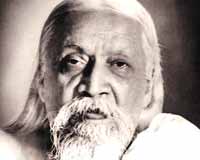 Early Life
Early Life
The life history of Sri Aurbindo says that he was born in Calcutta, on 15th
August 1872. At the young age of seven, he was sent to England to complete his
education. He studied at St. Paul's in London and at King's College, Cambridge,
learning Greek, Latin, French, German, Italian and Spanish alongside. As teenage
approached, he felt that his mission in life was to play a role in the
revolutionary changes emerging in the world and in India. After he came back to
India at the age of 21, he immersed himself in the study of Indian culture.
Participation in Politics
Shri Aurbindo became a leader of the group of Indian nationalists, the
Extremists, during the First Partition of Bengal. Later, he became one of the
founders of Jugantar party, an underground revolutionary outfit. He was also the
editor of Vande Mataram, a nationalist Bengali newspaper.
From Politics to Spirituality
Gradually, Sri Aurobindo started losing interest in politics and started getting
attracted towards spirituality. He met a yogi, Vishnu Bhaskar Lele, in Baroda,
who led him towards the ancient Hindu practices of yoga. He claimed to have the
divine vision of Swami Vivekananda in his meditations. After spending four years
in intense meditation at Pondicherry, Sri Aurobindo launched Arya, a 64 page
monthly review. In 1920, he was joined by his spiritual collaborator, known as
'The Mother'. With her, developed the concept of Auroville or the Sri Aurobindo
Ashram in Auroville.
Shri Aurbindo Teachings
Shri Aurobindo believed that human beings are not the end of the process of
evolution. They can evolve beyond the present state of ignorance to the future
state of Supramental existence. There is only one truth or reality in life and
that is 'The Truth of Existence'. This reality, also known as Brahman, is
absolute and not bounded by any limitations. We can recover this reality by
rising from ignorance and moving on the path of spirituality.
Auroville
Auroville or Aurobindo Ashram is a society, consisting of people dedicated to
the same goal of "Supramental Consciousness". It situated near the city of
Pondicherry and has been built to serve as the residence of upto 50,000 people
from around the world. It is like a model city of the future, which is based on
the spirit of universal brotherhood.
Avvaiyyar
About Avvaiyyar
Avvaiyyar was a female poet of the ninth century, who lived in the southern
parts of India. She is known, not only for her extraordinary poetry, but also,
as a noble and revered saint. The term 'Avvaiyyar' means ' respected old
woman' or 'Grandmother'. Even though her real name is not known, it doesn't
make her or her literary works any less popular. The children learning Tamil
language make use of one of her poems, which has been written especially for
the purpose. As we move further in this article, we will come across the
various stages in life history of Avvaiyar.
Early Life
As per the legends surrounding Avaiyyar Biography, she was born to a Brahman
called Bhagavan and his untouchable wife called Adi. Since Bhagavan was on a
spiritual journey at the time of her birth, both of them decided to abandon
the child. A poet passing from there noticed the abandoned child and took her
under his care. Right from childhood, Avvaiyyar showed a deep interest in
poetry. At the tender age of four, she was able to complete a complicated
verse that even the most distinguished poets of the land could not.
Devotion to Ganesha
Avvaiyar was extremely devoted to Lord Ganesha since childhood. She always
asked Him for three gifts, the gifts of poetry, music and drama. As she grew,
her talents also grew to the highest levels. At the same time, she also
started getting marriage proposals. Fed up with the proposal and being
constantly pressurized to get marries, Avaiyyar asked Lord Ganesha to remove
her beauty and turn her into an old woman. The Lord obliged and in
acknowledgment of His generosity, she sang a great paean of Praise for Him,
regarded as the equivalent of the Vedas.
Her Spiritual Journey
After this incident, she began her journey as a wanderer. The life gave her
the much desires education and inspiration and this social conscience started
to reflect in her poetry also. The love Avvaiyar had for the common man, her
contempt towards pretensions of the rich, etc, all were beautifully brought
forward in her poems. During her lifetime, Avvaiyar also came across Skanda,
brother of Ganesha. Her last public service was the prevention of the war
between King Adiyaman and King Thondiaman.
The Spiritual Journey Ends
It is believed that Avvaiyyar did not die a normal death. Instead, she was
transported bodily to Kailasha, the abode of Lord Shiva, by Lord Ganesha
Himself.
Chinmayananda
About Swami Chinmayananda
Swami Chinmayananda is counted amongst the most notable spiritual leaders in
India. He was considered as an authority on the ancient Indian scriptures,
especially the sacred Bhagwad Gita and the Upanishads. He was the founder of the
Chinmayananda Mission and also the author of more than 30 books, dedicated to
the philosophical belief behind religion. Read this biography on Swami
Chinmayananda further to know more about the great leader, his life history, his
mission, etc…
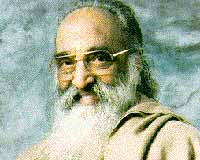 His Early Life
His Early Life
Swami Chinmayananda was born as Balakrishna Menon (Balan) in Ernakulam district
of Kerala, in 1916. He completed his graduation from the Lucknow University and
thereafter entered the field of journalism. Till that time, he felt that he
could influence the political, economic and social reform movement through
journalism.
Meeting Swami Sivananda
Meeting Swami Sivananda at Rishikesh proved to be a turning point in the life of
Balakrishna. He developed an interest in the path of spirituality. It was under
Swami Sivananda only that Balakrishna took Sanyas (asceticism) and became Swami
Chinmayananda. Seeing the enormous untapped potential of Swami Chinmayananda,
Swami Sivananda sent him to study under Swami Tapovan Maharaj in the Himalayas.
After studying for eight years under Swami Tapovan, Chinmayananda decided to
spread his knowledge amongst people.
Charitable Work
Swami Chinmayananda spent forty years of his life in helping others. He opened a
number of ashrams, schools, hospitals, nursing homes and clinics throughout the
world.
Recognition
Swami Chinmayananda was selected as the President of Hindu Religion by the Hindu
Host Committee in the year 1993. The honor was given to him at the Meeting of
the Parliament of World Religions in Chicago. He was also honored for serving
humanity selflessly throughout his life at "World Vision 2000," a conference of
religious leaders. Swami Chinmayananda left this world on August 3, 1993 to
become one with the Supreme Lord. He died in San Diego, California.
Chinmayananda Mission
Chinmayananda Mission was founded with an aim, to bring the timeless knowledge
of Vedanta closer to people. At the same time, it teaches them to way to attain
spiritual growth and contentment.
Dayanand Saraswati
About Dayanand Saraswati
The founder of Arya Samaj (the Society of Nobles), Swami Dayanand Saraswati
was one of the greatest religious leaders ever born in India. He was
responsible, to some an extent, in bringing back the age-old teaching
tradition of 'Gurukul'. He advocated for the equal right of women and
condemned practices such as untouchability, animal sacrifice, idol worship,
etc.
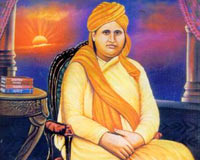 Early Life
Early Life
Swami Dayanand Saraswati was born as 'Moolashankar' in Gujarat, in the year
1824. Even when he was a child, Swami Dayanand Saraswati had a keen and
inquisitive mind. Once, Mool Shankar was keeping a fast on the Shivratri
festival day, along with his entire family. They had to be awake throughout
the night. At night, he saw a mouse dancing on the Shivalinga. Surprised at
this incident, he asked his elders
Born as Mool Shankar Tiwari to a pious Gujarati couple in 1824, Mool Shankar
had an inquisitive mind, and a compassionate nature from his childhood. Once
on a Shivaratri festival day, which is observed by fasting and keeping awake
the whole night in obedience to Lord Shiva, he saw a mouse dancing on the
Shivalinga idol. He tried to find out from elders why this "God Almighty"
could not defend himself against the menace of a petty mouse, for which he was
rebuked! The sudden death of a favorite uncle, and his beloved sister caused
much turmoil in Mool Shankar. He became quite detached from the world, and one
day left home, incognito in search of a guru.
The search was long and arduous. Finally, at the age of thirty-six he found
his mentor in Virajananda Saraswati, who was blind, but was a master of the
ancient lore. The training was rigorous, and the guru was ruthless. But here
was a disciple of a lifetime. As the teacher's fee (gurudakshina -- also has a
sacred connotation in Hindu thought; it cannot be denied) he wanted his
student to devote his life for the revival of Hinduism. The guru called him
Dayananda.
Philosophy of Swami Dayananda Saraswati
Dayanand Sarasvati believed that the Vedas were perfect and infallible.
Dayananda advocated the doctrine of karma, skepticism in dogma, and emphasised
the ideals of brahmacharya (celibacy and devotion to God).
Arya Samaj
Arya Samaj or the 'Society of Nobles' is a Hindu reform movement, founded by
Swami Dayanand Saraswati in the year 1875. The main principles, on which Arya
Samaj is based, condemn…
Gyaneshwar
About Gyaneshwar
It is difficult to pinpoint who exactly Gyaneshwar was. He had so many talents
in himself, that it is not easy to explain his contribution to the Indian
culture in a single sentence. He was a poet, an intellectual, a spiritual
leader, a master of yoga and an Enlightened One. As we move on further with
Gyaneshwar Biography, you will be able to see the many faucets of his
personality more clearly.
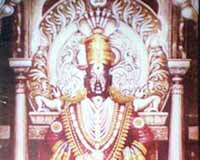 Early Life
Early Life
Gyaneshwar was born in the year 1271 in a small village near the Godavari River.
His father, Vithalpant, found married life annoying and deserted his wife to
seek refuge in the holy city of Benaras. However, the Guru who had initiated him
came to know about his wife and sent him back to his village. Later, four
children were born to them. The first was Nvrittinath, then Gyaneshwar (in
1271), another boy Sopana and a daughter Muktabai. All the siblings became great
spiritual leaders in their might. Read on further to know more about the life
history of Gyaneshwar…
Initiation into Spirituality
Sant Gnaneshwar was initiated by his elder brother, Nvrittinath. Soon after his
initiation, he realized that the Bhagvad Gita is the best text in satisfying the
spiritual needs of people. At the same time, he appreciated the fact that it is
difficult for the common people to comprehend the great text, since it was
written in Sanskrit. It was then that he took the decision to translate the
great text into a common language. With this, he laid the basis for Marathi
language.
Miracles
Many people came in the way of Jnaneshwar / Gyaneshwar and he won over them with
his knowledge as well a through his miracles. One story goes that he swayed a
troublemaker by making him see Muktabai, his sister, cook food over his back. It
implied that his spiritual power was so strong that the heat it gave served as
the fire for cooking. It is also said that he once gave back life to a dead
person. However, Gyaneshwar never ever mentioned his miracles in his own
writings.
Writings
Even though there are many renowned writings of Gyaneshwar, the ones that are
the most famous are the Gnyaneshwari and the Amritanumbhava. Gyaneshwari is the
interpretation of the Sacred Bhagvad Gita, while Amritanumbhava is the
outpouring of his devotion to god as well as the great saints. Today, Gyaneshwar
is regarded as one of the greatest as well as the most difficult philosophers
minds of India.
Sant Kabir
About Sant Kabir
Sant Kabir is considered to be one of the greatest poets as well as mystics
ever born in India. He believed that human beings are equal and being one with
God is the ultimate aim of every individual. His love and devotion towards the
Supreme One clearly reflects in his poetry. The Holy Guru Granth Sahib
contains over 500 verses by the great saint, Kabir. The verses or dohas of
Guru Kabir are still read by people with awe and admiration. Read on to
explore the biography of Sant Kabir further.
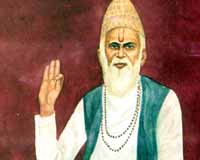 Early Life
Early Life
As per the life history of Saint Kabir, he was born in 1398 AD. It is said
that he was found floating on a lotus leaf in a tank in Benaras by a Muslim
weaver. The weaver took the vulnerable child under his care and following the
traditional manner, gave him the name of 'Kabir', meaning 'the great one'.
Even at a young age, Kabir displayed enormous spiritual talent.
Meeting his Guru
Kabir always wanted to become a disciple of Ramanand. However, since he was a
Muslim, it was next to impossible for him to get initiation from a Hindu. So,
he took recourse to a trick. Ramanand daily went to the bathing ghat for his
pre-dawn ritual ablutions. Kabir lay on the steps of the ghat in such a way
that Ramanand stepped on him. Shocked at this incident, he chanted 'Rama!
Rama!'. Kabir said that since he had received teachings from him, in the form
of the words 'Rama! Rama!', he was Ramanand's disciple. Impressed with the
intelligence of Kabir, Ramanand took him as his disciple.
Guru Kabir ke Dohe
The hallmark of Kabir's works consists of his two line couplets, known as the
'Kabir ke Dohe'. The Dohas reflect the deep philosophical thinking of the poet
saint.
The Philosophy of Sant Kabir
Sant Kabir believed in the Vedantic concepts of atman. He always advocated the
Impersonal Aspect of God (Nirguna) and therefore, was against idol worship. As
per his view, all human beings are equal and the societal caste system that is
so widely prevalent in our country is fallacious. He said that true guru is
the one who can be attained through direct experience. The common ways of
realizing God, like chanting, austerities, etc, are worthless.
Maharishi Mahesh Yogi
About Maharishi Mahesh Yogi
Maharishi Mahesh Yogi is the creator of the transcendental form of meditation,
along with being the leader of the Transcendental Meditation Movement. One of
the most renowned spiritual Gurus of India, he is highly influenced by the
principles of Adi Shankaracharya. The main aim of Maharishi Mahesh Yogi is to
promote the use of the Vedic ways in daily life. Read on to explore the
biography of Maharishi Mahesh Yogi further…
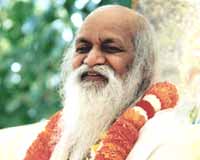 Early Life
Early Life
Maharishi Yogi was born in the year 1911, in Allahabad town (in Uttar Pradesh).
After graduating from Allahabad University (in physics), he spent 13 years under
the tutelage of Swami Brahmananda Saraswati. During this period, he developed an
inclination towards the ancient Vedic Science of consciousness. At the same
time, he started practicing intense meditation. He is also credited with making
efforts towards the restoration of the thousand-years-old scattered Vedic
Literature. He is responsible for organizing it as a complete science of
consciousness.
Upgradation from a Student to a Teacher
As per the life history of Maharishi Yogi, he assumed the title "Maharishi" in
1955. From then onwards, began his journey as a teacher of traditional
meditation technique, now known as Transcendental Meditation.
Mahesh Yogi Transcendental Meditation
Maharishi Mahesh Yogi aims at developing a society in which there is good all
around. The first step that he took towards the fulfillment of his aim was the
starting of the Transcendental Meditation Movement. Transcendental Meditation is
a mental technique that helps a person in achieving consciousness. It involves
the use of a mantra or sound, through which the mind becomes alert, but the body
feels relaxed. He has also established a number of foundations to support his
movement, one of which is The Spiritual Regeneration Movement, founded in 1957.
The Maharishi Effect
Various studies have been conducted throughout the world to ascertain the
effects of Transcendental Meditation. It has been found out that the places
where even one percent of the population practiced Transcendental Meditation,
the crime rate was found to be declining. This phenomenon, where Transcendental
Meditation is seen as being negatively related to crime, violence and other
negative forces, is known as the Maharishi Effect.
Anandamayi Ma
About Mata Amritanandamayi
Mata Amritanandamayi Devi is one of the most loved and most respected
spiritual leaders in India. Fondly known as Amma, she has only one aim in
life, which is to provide people with her supreme guidance and lead them on a
path of sadhana (meditation) and service of the mankind. She is also called
the 'Hugging Saint', since she hugs each and every individual who comes to
attend her discourses. Read on to explore the biography of Mata Amritanandmayi
further…
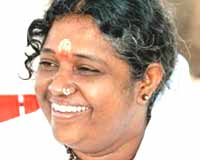 Amritanandamayi Devi Life History
Amritanandamayi Devi Life History
Amritanandamayi Devi was born as Sudhamani in September 1953, in a small
fishing village of Parayakadavu, Kerala. Unlike other newborn infants,
Sudhamani did not come into this world crying. Even at that time, she was
smiling and there was a serene glow on her face. Right from her childhood,
Mata Amritanandmayi was deeply inclined towards spiritual practices. She could
be frequently seen engrossed in deep meditation, totally unaware of her
surroundings.
Sudhamani was always deeply attached to her fellow human beings. She was quit
affected by the suffering of others and went out of her way to alleviate their
pain. Today, the little girl has grown-up to become Mata Amritanandmayi Devi,
one of the most revered spiritual leaders of her time. Since the past 35
years, she has been working relentlessly towards easing the sufferings in this
world.
Mata Amritanandamayi Mission
Her sole mission in life is to "love and serve one and all". She is totally
devoted to the well being of the mankind. Her soothing words, her calm voice,
and her calm and composed personality easily makes one forget all the miseries
in life.
Mata Amritanandmayi Ashram
Mata Amritanandmayi Ashram is situated in Amritapuri, amidst the backwaters of
Kerala. For all those people who have become tired with the pain and suffering
in life, the ashram serves as a welcome retreat. The peaceful and serene
ambience of the ashram, combined with the simplicity of Amma's discourses,
provides a welcome relief from the ill will so widespread in this world.
Recognitions to Mata Amritanandamayi Devi
In 1993, Mata Amritanandamayi was elected as one of the presidents of the
assembly of global religions, which was held in Chicago. At the same time,
Hinduism Today, an international journal on Indian culture, honored her by
giving her the 'Hindu Renaissance Award'. She even spoke at the Interfaith
Celebrations in New York, held in commemoration of the 50th anniversary of the
United Nations. In 2002, she was invited as the central speaker at The Global
Peace Initiative of Women Religious and Spiritual Leaders, held in Geneva. In
the same year, she was also presented with "Gandhi-King Award for
Non-Violence", by The World Movement for Nonviolence.
Mira Alfassa
About Mira Alfassa 'The Mother'
Mira Alfassa, later named as 'The Mother', was the spiritual partner of Sri
Aurobindo. After Sri Aurobindo renounced the worldly life and went into
seclusion, she looked after Auroville, also known as Sri Aurobindo Ashram.
Read on to know more about the biography of Mirra Alfassa 'The Mother'.
Early Life
The Mother was born as Mira Alfassa in the year 1878, in France. Her mother
was an Egyptian, while her father was Turkish. She also had an older brother
named Matteo. Mira Alfassa lost all interest in worldly life when she was only
five years old and from then onwards began her journey on the path of
meditation and spirituality. As per 'The Mother' herself, she had a number of
psychic and spiritual experiences between the age of eleven and thirteen.
Through these visions, she came to realize the existence of God. In the year
1897, she got married to Henri Morisset, a student of Moreau.
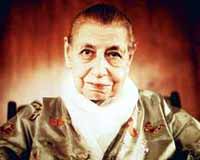 Receiving Enlightenment
Receiving Enlightenment
As per Mira Alfassa, she received enlightenment between the age of nineteen
and twenty, without the help of any books or teachers. Later, she took
recourse to Raja Yoga and the"Bhagwad Gita" to move forward on the path of
spirituality.
Meeting Max Théon
Mira Alfassa met the mysterious occultist, Max Théon, who helped her in
understanding the psychic visions she had so often experienced. In 1908, Mirra
divorced Morisset and moved to Paris. Around 1910, she again got married to
Paul Richard.
Meeting Sri Aurobindo
Mira, along with her husband Paul Richard, left for India on 7th March 1914.
They reached Pondicherry on 29th March and met Sri Aurobindo. It is said that
the moment Mira saw Sri Aurobindo she recognized him as person she saw in her
visions of a dark Asiatic figure. Mira and Paul left for France in February
1915. However, they came back to Pondicherry in April 1920 and from 1922, she
started regular evening talks and group meditations. Mira Alfassa was given
the name of 'The Mother by Sri Aurobindo only.
Taking Charge of Aurobindo Ashram
In December 1926, Sri Aurobindo decided to renounce the world and retire from
the public view. In his place, he appointed Mira Alfassa to take over the
administration of Aurobindo Ashram, later named Auroville. In 1973, Mira
Alfassa, 'The Mother', left this world to become one with the Supreme Being.
Mother Teresa
About Mother Teresa
Saint Mother Teresa is perhaps the greatest human being who has ever lived in
this world. She was beatified by Pope John Paul II in October 2003. She had
only one aim in life, to serve the poor, the destitute, the needy and all
those who were dejected by the society. Mother Theresa founded an institution,
known as 'The Missionary of Charity' to help her in fulfilling this aim. Read
on this biography to know more about Saint Mother Teresa.
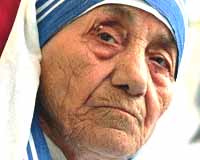 Early Life
Early Life
As per her life history, Mother Teressa was born as Agnes Gonxha Bojaxhiu on
26th August 1910. At the young age of twelve, Agnes started to feel
disinterest in the worldly affairs. By the age of eighteen, she was determined
to become a nun and left her home to join the Convent of Our Lady of Loreto in
Dublin. She undertook the name Teresa in the year 1931 and at the same time,
she took her vows.
Coming to Calcutta (Kolkata)
Mother Theresa came to Calcutta (now Kolkata) in the year 1937 and joined St.
Mary's High School. It was here that she fully comprehended her true calling
in life, which was to serve the needy and rejected people of the society.
Founding Missionaries of Charity
To help her in attaining her goal in life, Mother Theresa wanted to start a
diocesan congregation. However, for this she required the permission of the
Vatican. The permission came in 1950 and thus was born 'The Missionary of
Charity'. In 1965, Mother Teresa was awarded a Decree of Praise by Pope Paul
VI and with this, she received the permission to expand her order to other
countries. Toda, the Missionaries of Charity boasts of 4,000 nuns and branches
in 133 countries of the world.
The Noble Peace Prize
Mother Teresa was awarded the Noble Peace Prize in the year 1979. She accepted
the prize as a representative of the 'poorest of the poor'. Mother Teresa
breathed her last on September 5, 1997, leaving behind a legacy of love and
sacrifice.
Namadeva
About Namadeva
Namadeva was one of the most famous poet saints of the thirteenth and
fourteenth century. He was the composer of hundreds of 'abhangs' (devotional
songs). Even today, devotees can be seen singing the beautiful abhangs of
Namadeva. Read on this biography to know more about Namadeva…
His Life
There is an interesting legend associated with the birth of Namadeva. It is
said that Damashet, after being persuaded by his wife, went to the temple of
Lord Panduranga to pray for a child. The same night, Lord Panduranga appeared
in his dream and asked him to go to the ghats of Bhima River the next morning.
He told Damashet that there will be a floating shell in the river, in which he
will find small child. He may take that child to his care and treat him as his
own child.
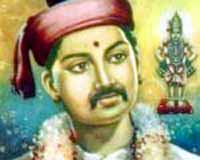 Damashet did as told and came back with an infant in his arms. Damashet, and
his wife, Gonayi gave him the name 'Nama'. Nama showed deep dedication to the
Lord right from his childhood. As Namadeva grew older, his devotion towards
also grew. Namadeva got married to a girl named Rajayi (or Radha Bai). They
had four children, namely Narayana, Vitthala, Govinda and Mahadeva. Namdeva
spent all his life in the devotion of the great Lord Panduranga and left for
the holy abode in the year 1350.
Damashet did as told and came back with an infant in his arms. Damashet, and
his wife, Gonayi gave him the name 'Nama'. Nama showed deep dedication to the
Lord right from his childhood. As Namadeva grew older, his devotion towards
also grew. Namadeva got married to a girl named Rajayi (or Radha Bai). They
had four children, namely Narayana, Vitthala, Govinda and Mahadeva. Namdeva
spent all his life in the devotion of the great Lord Panduranga and left for
the holy abode in the year 1350.
Osho Rajneesh
About Osho Rajneesh
Osho was one of the most renowned as well as most controversial spiritual
leaders of his times. During the 1970s and 1980s, he was known as Bhagwan
Shree Rajneesh. Later, he changed his name to 'Osho'. He was the founder of
Osho movement, a controversial spiritual and philosophical movement.
Early Life
Osho, also known as the Zen Master, was born as Rajneesh Chandra Mohan Jain on
11th December 1931, in Narsinghpur District of Madhya Pradesh. Even though he
was born to parents of Jain religion, he never adhered to any particular
religious faith in his lifetime. Throughout hid childhood, Osho came across as
a highly intellectual, but rebellious student. One of the major influences in
his life were his grandfather and grandmother, with whom he spent the first
seven years of his life.
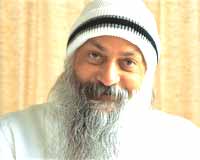 Receiving Enlightenment
Receiving Enlightenment
As per Osho, he received enlightenment in the year 1953, at the age of 21.
Thereafter, he finished his graduation and post graduation in Philosophy from
D. N. Jain College, Saugar University. For a few years, he taught philosophy,
first at Raipur Sanskrit College, and then, at Jabalpur University. During
that time, he traveled throughout the country, giving lectures on socialism
and Gandhi. The first meditation camp was organized by Osho in 1964. In 1966,
he quit his job as a professor and then onwards, started his journey as one of
the greatest spiritual leaders of India.
Establishment of Osho Foundation
The followers and disciples of Osho established a foundation in his name, in
the year 1969. The headquarters of the foundation was set up on the ground
floor of a building in Mumbai. Later, due to space constraints and the bad
weather of Mumbai, the headquarters were shifted to the Koregaon Park, Pune.
The ashram is today known as Osho International Meditation Resort.
Period of Public Silence
After giving discourses on a daily basis for a period of almost 15 years, Osho
went into a three-and-a-half-year period of public silence in the year 1981.
During that period, his discourses were replaced by satsangs (silent sitting,
with some readings from his works and music). The public silence came to an
end in 1984 and he resumed his daily discourses once again.
The Last World Tour
In 1985-86, Osho went on a world tour to spread the understanding of
spirituality. After being refused by a number of countries, he came back to
India in 1986. From 1987, he again started giving discourses at his ashram in
Pune. Osho forfeited the name of 'Bhagwan Rajneesh' in the year 1989 and took
the name of Osho. Osho breathed his last in 1990, at the age of 58.
Zen Master Osho
Osho is also known as the Zen (concentration) Master as he managed to attain a
very high level of meditative trance.
Osho Philosophy
As per Osho, there is nothing more valuable or precious in this world than
love, meditation and laughter. Enlightenment the normal state in which a human
being lives. It is because of being bounded in the emotional ties that he
fails to recognize this state. Meditation is not something that needs to be
taught, it is the state of just being.
Osho Dham
Osho Dham at Pune is known as Osho International Meditation Resort. People
from various parts of the country as well as the world come to this ashram or
dham to learn meditation or even just relax and rejuvenate.
Paramahansa Yogananda
About Paramahansa Yogananda
Guru Paramahansa Yogananda was one of the distinguished yogis of India. He was
the one responsible for taking the teachings of meditation and Kriya Yoga to
the western countries. He was also the author of a very renowned book
'Autobiography of a Yogi', which has introduced people time and again to the
timeless wisdom of India. Read on to explore the biography of Guru Paramhansa
Yogananda further…
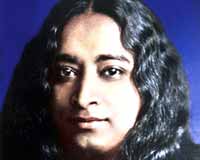 Early Life
Early Life
One can easily know about the life history of Paramahamsa Yogananda in his
book 'The Autobiography of a Yogi'. He was born as Mukunda Lal Ghosh in
Gorakhpur, Uttar Pradesh, into a Bengali family. From a very young age,
Mukunda demonstrated great awareness about the spiritual realm. His youth was
mostly spent in finding a guru (teacher), who could provide him with guidance
and correctly direct him towards the path of spirituality.
Meeting Swami Sri Yukteswar Giri
The search of Paramhansa Yogananda came to an end when he met Swami Sri
Yukteswar Giri. At that point of time, he was only seventeen years of age.
Thereafter, he completed his Intermediate (in Arts) from the Scottish Church
College, Calcutta and did his graduation (in religious studies) from the
Serampore College, Calcutta University.
Joining the Monastic Swami Order
In 1915, Paramahansa Yogananda formally joined the monastic Swami Order by
taking his vows. He, thus, became 'Swami Yogananda Giri'. Paramhansa started
his journey in the world of spirituality by establishing a boy's school,
Dihika, in a remote hamlet of Bengal. The school got relocated to Ranchi a
year later and today it is known as Yogoda Satsanga Society of India, the
Indian branch of Yogananda's American organization.
Other Events in the Life of Paramahansa Yogananda
Paramhansa visited USA in 1920 as an Indian delegate, to attend the
International Congress of Religious Liberals, being held in Boston. In the
same year, he established Self-Realization Fellowship, a vehicle for preaching
Yoga and meditation worldwide. He spent the next few years abroad, teaching
Yoga and its philosophy. In 1925, he set up the headquarters of the
Self-Realization Fellowship in Los Angeles. In 1935, he came to India and
established Yogoda Satsanga of India. He also visited Mahatma Gandhi and a
number of famous personalities during that time. He went back to USA the next
year and it was there that he completed his journey in this world, in the year
1952.
Autobiography of a Yogi
Paramahamsa Yogananda wrote his own life story by the name of 'Autobiography
of a Yogi', in the year 1946. It served as a major vehicle for the
introduction and promotion of meditation and yoga in the western countries.
Till date, it has been translated into almost 18 languages and still counts
amongst the bestsellers. In the book, Yogananda has tried to explain certain
verses and events of the Bible, along with his rendezvous with a number of
leading spiritual personalities.
Pandurang Shastri Athavale
Pandurang Shastri Athavale, popularly known as Dada, is a philosopher cum
social reformer. He is credited with being the founder of the Swadhyay
Movement. Not present in the world anymore, Pandurang Shastri Vaijnath
Athavale was known for giving extremely moving discourses on Srimad Bhagavad
Gita and Upanishads. Infact, he tried to motivate his followers to spread
the thoughts of Geeta in the society. Given below is the complete biography
of Pandurang Shastri Athavale
His Life History
Pandurang Shastri Athavale was born on 19th October 1920, in the Roha
village near Mumbai city. His grandfather was Laxman Rao, a renowned scholar
and Brahmin who was involved in the spread of Bhagavad Gita amongst the
Dalits. Pandurang grew up watching his grandfather go to the Dalit area and
then take a bath after coming back home. Surprised by this act, he asked
Laxman "If in the Bhagavad Gita the Lord exclaims that God exists within all
human hearts, then how can anyone, including the so-called 'untouchables',
be considered inferior to anyone else?"
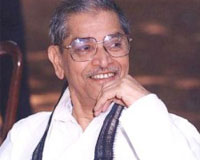 After
that, he made a vow to himself that he would always try to see the God
within others. Hence, he became the proponent of the concept of "In-dwelling
God". By the age of 22 years, Pandurang Shastri Athavale started giving
discourses at the Shrimad Bhagavad Gita Pathshala, a school that was set up
by his father. In the year 1954, he attended the Second World Religions
Conference, which was held in Japan. At the conference, he delivered a
speech on the concepts of Vedic ideals as well as the teachings of the
Bhagavad Gita. After
that, he made a vow to himself that he would always try to see the God
within others. Hence, he became the proponent of the concept of "In-dwelling
God". By the age of 22 years, Pandurang Shastri Athavale started giving
discourses at the Shrimad Bhagavad Gita Pathshala, a school that was set up
by his father. In the year 1954, he attended the Second World Religions
Conference, which was held in Japan. At the conference, he delivered a
speech on the concepts of Vedic ideals as well as the teachings of the
Bhagavad Gita.
Even though most of the people rebuffed his views; there was one person who
was very impressed with him. He was Dr. Wilson Compton, who then offered
Pandurang a post in the USA to spread his ideas and views. However,
Pandurang politely turned down the offer. He then devoted himself in
establishing a model community, through the spread of Vedic thoughts and
message of the Bhagavad Gita. Thus was born the Swadhyay (meaning 'self
study') Movement, which spread the message of the holy book not only in
India, but the whole world.
The family members of the Swadhyay Pariwar are called 'Swadhyayees' and
include people from the upper as well as the lower classes. The Swadhyayees
who spread the ideas of Athavale throughout the country are known as
"Krutisheels' or the people of action. Pandurang Shastri Athavale also
founded an institute, known as Tatvagyan Vidhyapeeth, where young people
study and learn his views and ideas. Pandurang left for the holy abode on
25th October 2003, in Mumbai. His adopted daughter, Jayshree Talwalkar, is
carrying on his work today.
Recognition
-
Ramon Magsaysay Award in Manila, Philippines (1996) - for community
leadership
-
Templeton Prize in Westminster Abbey, London (1997)
-
Padma Vibhushan (1998) - for his efforts towards social reform
Ramakrishna Paramahansa
About Ramakrishna
Ramakrishna was one of the greatest religious leaders ever born in India. He
believed that every individual must have only one aim in life i.e., the
realization of the Ultimate Reality. To achieve this aim, one of the
preconditions is the purity of mind. He also played a significant role in
the Bengal Renaissance of the 19th century. His disciple, Swami Vivekanada,
founded the Rama Krishna Mission after his demise, to propagate his
teachings throughout the world. Read on the biography further to know more
about Sri Ramakrishna.
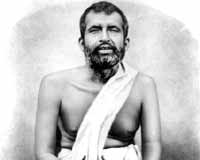 His Life
His Life
As per his life history, Sri Ramakrishna Paramahansa was born as Gadadhar
Chattopadhyay in the year 1836. When thetime came for Gadadhar to be
ritually initiated as a Brahmin, he declared that he would take his first
arms not from a Brahmin, but a certain low-caste woman of the village. No
amount of persuasion could make him budge from his stand. Finally, Ramkumar,
the elder brother of Ramakrishna, gave in to his wishes. After the passing
away of his father, Ramkumar took the position of a priest in the
Dakshineswar Temple. The same position was later occupied by Rama Krishna,
after the retirement of his brother.
Initiation
A wandering monk, known as Totapuri, initiated Ramakrishna in the Advaita
Vedanta. The initiation took place in the city of Dakshineswar. It is said
that after being initiated by Totapuri, Rama Krishna remained in a state of
absolute meditation, for a period of approximately six months.
Marriage and Later Life
Ramakrishna married Sarada, when she was only five years old. His wife,
Sarada became his first disciple. After the passing away of Ramakrishna,
Sarada became a religious leader in her own right. With time, Ramakrishna
came to be known as Ramakrishna Paramahansa. He developed throat cancer in
the later years of his life and breathed his last on16 August, 1886.
Rama Krishna Mission
Swami Vivekananda, a disciple of Ramakrishna Paramahansa, founded the Rama
Krishna Mission to promote the teachings of his Guru. Headquartered at the
Ramakrishna Ashram of Belur, the mission aims at helping people in attaining
salvation.
Teachings of Ramakrishna
Ramakrishna believed and taught that…
-
All living beings are divine.
-
Human beings are equal and there is oneness of existence.
-
The main obstructions in the attainment of salvation are lust and greed.
-
There is only one God.
-
The main aim of each and every human being is to become one with God.
Ramdev Baba
About Ramdev Baba
Baba Ramdev is a renowned Yoga teacher. Through the medium of television, he
has taken the art of yoga to each and every household far and wide. He is
the host of a program named 'Divya Yog' that airs on Aastha TV everyday, at
5 am in the morning. People from different parts of the country watch this
program and have started doing yoga from the comforts of their home.
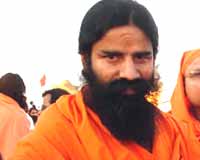 Early Life
Early Life
Swami Ramdev was born as Ramkishan Yadav in the Mahendragarh district of
Haryana. After studying at school till the eight standard, he joined a yogic
monastery (gurukul) in Khanpur village. There, he started learning the
techniques of Yoga, along with the Sanskrit language.
Renunciation
After completing his period of study at the Gurukul, Baba Ram Dev renounced
the world and entered into Sanyas (monastic living). It was then that he
assumed the name of Ramdev. He went to Jind district and joined the Kalva
gurukul. There, he started teaching Yoga to the villagers across Haryana. It
is believed that some time later, he traveled to the Himalayas, spending a
number of years there. Thereafter, he went to Haridwar and till date, the
city serves as his base.
Initiation into Ascetic Order
Swami Ramdev was initiated into the ascetic order by Swami Shankerdevji
Maharaj. After his initiation, he joined the order of swamis and started
studying the ancient Indian scriptures. At the same time, he also practiced
intense self-discipline and meditation.
Divya Yoga Mandir Trust
As a promotional vehicle for Yoga, Baba Ram Dev established the Divya Yoga
Mandir Trust in 1995. In this project, he was accompanied by Acharya
Karamveer and Acharya Balkrishna. The headquarters of the trust are at the
Kripalu Bagh Ashram of Haridwar. Baba Ramdev teaches yoga mainly at this
ashram.
Baba Ram Dev Yoga
Baba Ramdev teaches Pranayama, a form of Yoga. The program consists of six
breathing exercises, practiced in the following sequence…
-
Bhastrika Pranayama
-
Kapal Bhati Pranayama
-
Bahaya Pranayama
-
Anulom Vilom Pranayama
-
Bhramri Pranayama
-
Udgeeth Pranayama
Sathya Sai Baba
About Sathya Sai Baba
A great spiritual leader, Sri Sathya Sai Baba preaches the path of
spirituality to one and all. His main aim in life is to serve the mankind
and provide tem with proper guidance, towards which He has been working
since the age of 14 years. Devotees from far and wide visit Sathya Sai Baba
Ashram, situated at Puttaparthi, to seek His blessings. Read on this
biography of Sri Sathya Sai Baba to know about His life history.
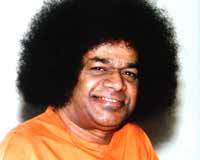 His Life
His Life
Shri Satya Sai Baba was born as Sathyanarayana Raju in the small village of
Puttaparthi, in Andhra Pradesh. Raju completed Elementary School at
Bukkapatnam and then joined the high school at Uravakonda. At Uravakonda, He
claimed of being bitten by a scorpion, which nobody could find. As a result
of this incident, he went into deep coma. After he came out from coma, Raju
started behaving in a strange manner, not eating food, reciting ancient
shalokas, etc. Finally, at the age of fourteen, he realized His true calling
in life and renounced the world.
Sathya Sai Baba Ashram Puttaparthi
Puttaparthi claims the distinction of housing the main ashram of Sathya Sai
Baba. It is known by the name of Prasanthi Nilayam and was inaugurated by
the Baba in the year 1950, on his 25th birthday.
Teachings of Shri Satya Sai Baba
The summary of the main teachings of Baba is given below…
-
The devotion of a person towards a particular religion is more important
the religion itself.
-
No religion is superior and no religion is inferior. We should respect
the religions of one other.
-
The country in which you stay should be respected and honored.
-
There is only one God in this world, His names may be different.
-
The service towards the poor, the needy and the sick should be without
expectation of any return.
-
Truth, divine love, right conduct, good behavior, peace and non-violence
are the values to be followed in everyday life.
|
 His Life
His Life  Early Life
Early Life Early Life
Early Life Meeting Shri Vallabharacharya
Meeting Shri Vallabharacharya  Early Life
Early Life  At
nineteen years, he decided to find a Guru who would guide him towards the
highest state of consciousness and left his house in this pursuit. It was in
the year 1943 that he met Yoga Master Swami Sivananda Saraswati in Rishikesh
city of Uttar Pradesh and his search came to an end. He stayed with the Guru
for a period of three years. Thereafter, he was initiated by Sivananda
Saraswati into the Dashnami order, as a Poorna as well as a Paramahamsa
Sanyasi. He was then given the name of 'Swami Satyananda Saraswati'.
At
nineteen years, he decided to find a Guru who would guide him towards the
highest state of consciousness and left his house in this pursuit. It was in
the year 1943 that he met Yoga Master Swami Sivananda Saraswati in Rishikesh
city of Uttar Pradesh and his search came to an end. He stayed with the Guru
for a period of three years. Thereafter, he was initiated by Sivananda
Saraswati into the Dashnami order, as a Poorna as well as a Paramahamsa
Sanyasi. He was then given the name of 'Swami Satyananda Saraswati'.  One
afternoon, Sadhguru Jaggi Vasudev went to the Chamundi hills and sat on a
rock with his eyes wide open. Suddenly, he had an out of body experience. He
felt as if he was not in his body anymore, rather spread out everywhere, in
the rocks, in the trees, in the earth. By the time he came back to his
senses, it was already evening. In the days that followed, Vasudev
experienced the same situated again, a number of times. Whenever, he
underwent such an experience, he went without food and sleep for the next
three or four days.
One
afternoon, Sadhguru Jaggi Vasudev went to the Chamundi hills and sat on a
rock with his eyes wide open. Suddenly, he had an out of body experience. He
felt as if he was not in his body anymore, rather spread out everywhere, in
the rocks, in the trees, in the earth. By the time he came back to his
senses, it was already evening. In the days that followed, Vasudev
experienced the same situated again, a number of times. Whenever, he
underwent such an experience, he went without food and sleep for the next
three or four days.  In
the year 1929, Jois ran away from his home and went to Mysore, in order to
study Sanskrit. By coincidence, Krishnamacharya also left Hassan to teach
somewhere else. Somehow, he also made his way to Mysore and met Jois once
again after a gap of two years. During this time, Krishnamacharya had cured
Maharaja of Mysore, Krishna Rajendra Wodeyar, of a very seriously illness.
As an expression of his gratitude, the Maharaja had established a Yoga shala
for him on the palace grounds.
In
the year 1929, Jois ran away from his home and went to Mysore, in order to
study Sanskrit. By coincidence, Krishnamacharya also left Hassan to teach
somewhere else. Somehow, he also made his way to Mysore and met Jois once
again after a gap of two years. During this time, Krishnamacharya had cured
Maharaja of Mysore, Krishna Rajendra Wodeyar, of a very seriously illness.
As an expression of his gratitude, the Maharaja had established a Yoga shala
for him on the palace grounds.  In
the process, he came across Yogi Paramananda Avadhoot, a great ascetic who
helped him in perfecting shunya (void) samadhi. However, his search for a
real guru ended when he met Avadhoot Swami Atmanand ji in a cave near
Gangotri (in Himalayas). From Atmanand ji, he got to learn Samprajnata
samadhi and awareness of various processes of nature in the state of
samadhi, the ultimate divine knowledge. Throughout his life, he kept meeting
great ascetics, learned from them and attained higher stages in yoga and
meditation.
In
the process, he came across Yogi Paramananda Avadhoot, a great ascetic who
helped him in perfecting shunya (void) samadhi. However, his search for a
real guru ended when he met Avadhoot Swami Atmanand ji in a cave near
Gangotri (in Himalayas). From Atmanand ji, he got to learn Samprajnata
samadhi and awareness of various processes of nature in the state of
samadhi, the ultimate divine knowledge. Throughout his life, he kept meeting
great ascetics, learned from them and attained higher stages in yoga and
meditation.  Enlightenment
Enlightenment His Early Life
His Early Life  His Life
His Life  His Life
His Life 
 Childhood of Adi Shankaracharya
Childhood of Adi Shankaracharya Early Life
Early Life  Both
of them went to the Himalayas, where the boy stayed for the next ten years.
Guru Sukhdev, a Sufi fakir sent him to learn from different gurus, like Sufi,
Buddhist and Hindu. Under these gurus, he learnt as well as mastered Ayurveda,
Tantra, Mantra, Sufism, Jainism and Buddhism. Thereafter, Bharat Thakur
studied different forms of Yoga, like Hatha Yoga, Ashtanga Yoga, Karma Yoga
and Kundalini Yoga, under Guru Sukhdev.
Both
of them went to the Himalayas, where the boy stayed for the next ten years.
Guru Sukhdev, a Sufi fakir sent him to learn from different gurus, like Sufi,
Buddhist and Hindu. Under these gurus, he learnt as well as mastered Ayurveda,
Tantra, Mantra, Sufism, Jainism and Buddhism. Thereafter, Bharat Thakur
studied different forms of Yoga, like Hatha Yoga, Ashtanga Yoga, Karma Yoga
and Kundalini Yoga, under Guru Sukhdev.  Bikram
practiced yoga rigorously, devoting four to six hours every day towards it.
When he was only thirteen years old, he won the National India Yoga
Championship and kept claiming the title for the next three years also.
Thereafter he retired as the undisputed 'All-India National Yoga Champion'. At
the age of seventeen years, Bikram Choudhury got badly injured in the knee
during a weight-lifting accident. Renowned doctors, from as far as Europe,
gave up the chances of his ever walking again.
Bikram
practiced yoga rigorously, devoting four to six hours every day towards it.
When he was only thirteen years old, he won the National India Yoga
Championship and kept claiming the title for the next three years also.
Thereafter he retired as the undisputed 'All-India National Yoga Champion'. At
the age of seventeen years, Bikram Choudhury got badly injured in the knee
during a weight-lifting accident. Renowned doctors, from as far as Europe,
gave up the chances of his ever walking again.  His Life History
His Life History Early Life
Early Life  His Early Life
His Early Life  Early Life
Early Life Early Life
Early Life  Early Life
Early Life  Early Life
Early Life  Amritanandamayi Devi Life History
Amritanandamayi Devi Life History  Receiving Enlightenment
Receiving Enlightenment  Early Life
Early Life  Damashet did as told and came back with an infant in his arms. Damashet, and
his wife, Gonayi gave him the name 'Nama'. Nama showed deep dedication to the
Lord right from his childhood. As Namadeva grew older, his devotion towards
also grew. Namadeva got married to a girl named Rajayi (or Radha Bai). They
had four children, namely Narayana, Vitthala, Govinda and Mahadeva. Namdeva
spent all his life in the devotion of the great Lord Panduranga and left for
the holy abode in the year 1350.
Damashet did as told and came back with an infant in his arms. Damashet, and
his wife, Gonayi gave him the name 'Nama'. Nama showed deep dedication to the
Lord right from his childhood. As Namadeva grew older, his devotion towards
also grew. Namadeva got married to a girl named Rajayi (or Radha Bai). They
had four children, namely Narayana, Vitthala, Govinda and Mahadeva. Namdeva
spent all his life in the devotion of the great Lord Panduranga and left for
the holy abode in the year 1350. Receiving Enlightenment
Receiving Enlightenment  Early Life
Early Life  After
that, he made a vow to himself that he would always try to see the God
within others. Hence, he became the proponent of the concept of "In-dwelling
God". By the age of 22 years, Pandurang Shastri Athavale started giving
discourses at the Shrimad Bhagavad Gita Pathshala, a school that was set up
by his father. In the year 1954, he attended the Second World Religions
Conference, which was held in Japan. At the conference, he delivered a
speech on the concepts of Vedic ideals as well as the teachings of the
Bhagavad Gita.
After
that, he made a vow to himself that he would always try to see the God
within others. Hence, he became the proponent of the concept of "In-dwelling
God". By the age of 22 years, Pandurang Shastri Athavale started giving
discourses at the Shrimad Bhagavad Gita Pathshala, a school that was set up
by his father. In the year 1954, he attended the Second World Religions
Conference, which was held in Japan. At the conference, he delivered a
speech on the concepts of Vedic ideals as well as the teachings of the
Bhagavad Gita. His Life
His Life  Early Life
Early Life  His Life
His Life